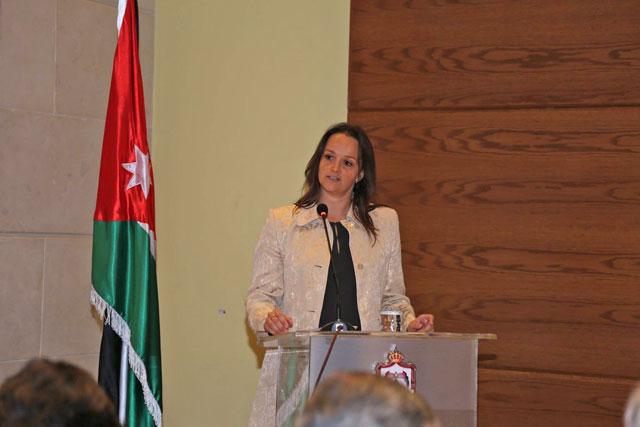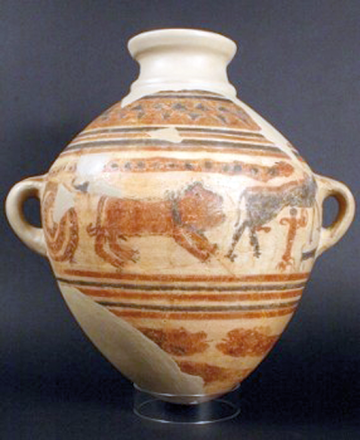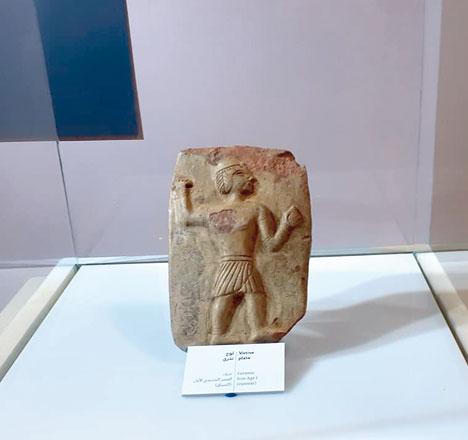You are here
Two German books on archaeology in Jordan launched in at the Jordan Museum
By Saeb Rawashdeh - Mar 06,2018 - Last updated at Mar 06,2018

GPIA Director Katharina Schmidt speaks at the book launch at the Jordan Museum on Sunday (Photo courtesy of the Jordan Museum)
AMMAN — Two German books — “Das Geheimnis des Tells” (Secrets of the Tell) and “Tell Ziraa: The Gadara region Project (2001-2011)” — were launched in Arabic on Sunday at the Jordan Museum by the German Protestant Institute of Archaeology (GPIA).
The event brought together experienced scholars, former and current directors of GPIA, representatives of Amman’s private schools and Goethe Institute.
Thanking HRH Princess Sumaya for the constant support, GPIA Director Katharina Schmidt highlighted the importance of the Arabic version of “Secrets of the Tell” to the younger generation of school children who may choose archaeology and history as their professional path.
“I’m particularly happy to welcome the author of the book, Professor Dieter Vieweger, who is also the general director of GPIA,” Schmidt said, noting that he worked at many different sites in Jordan and the Near East.
GPIA, a scientific research centre which focuses on archaeology, works very closely with different Jordanian partners, particularly the Department of Antiquities, Schmidt stressed.
The book “Secrets of the Tell” was initially written in German to create a tool for young people to learn more about the basics of archaeology, and became very popular, she noted, adding that the decision was made to prepare the version in the Arabic language in order to make it available for pupils, families and “everybody in Jordan and the Arab world”.
These events unify archaeological research and education, the director emphasised, and illustrate how the general community should deal with archaeological work and cultural heritage in general.
“Archaeological sites shouldn’t only be explored and excavated for the sake of research, but also for pupils and everybody who is interested in history, archaeology, preservation and cultural heritage,” she underlined.
Material culture is immensely important to humankind, since it tells us something about our past and the way our ancestors and great ancestors lived and viewed the world, Schmidt elaborated.
However, cultural heritage is in great danger because many sites are being destroyed, and once an archaeological site is destroyed, nothing can rebuild it, she warned.
Regarding the second, more scholarly book, “Tell Ziraa: The Gadara region Project (2001-2011)”, archaeologist and former GPIA director Jutta Häser said that in the late 1990s, Professor Dieter Veiweger, the then-professor for Old Testament and Biblical Archaeology, initiated Gadara Region Project in the northern part of Jordan.
Following an intensive survey in that region, the first excavation at Tell Ziraa (some 4.5km west of Gadara) began in 2004, and it was the joint project between the Biblical Archaeological Institute and a GPIA, Häser said.
“The excavations give an insight into 5,000 years of history in Jordan and the southern Levant,” she highlighted, adding that the development of the settlement is outstanding since there are no settlement gaps unlike other excavation sites.
Furthermore, the finds demonstrate the location of Tell Ziraa in “a contact zone” between the cultural spheres of Mesopotamia, Syria, Egypt and the Mediterranean region connected by important trade routes.
“Inhabitants of Tell Zira were influenced by the different cultural traits,” the researcher continued, noting that regarding the artistic developments, they created unique forms of expression such as a pot with a scene of animals and a lyre playing man, as well as a ceramic plate with the depiction of a king and his enemies.
“Fifty of the most interesting and often unique finds couldn’t be seen in the permanent exhibition of the Jordan Museum,” Häser explained.
In 2011, two researchers decided to interrupt excavations to prepare the publication of already found archaeological material.
“Today, we are glad to present the first volume of a series of altogether nine volumes, which gives an introduction to the Gadara Region Project,” she announced, concluding that the second volume will be ready this year, while further volumes will be published in the next three years.
Related Articles
AMMAN — A number of objects have been excavated from Tell Zira’a (located around five kilometres southwest of ancient Gadara) by the German
IRBID — After being on display at the Jordan Museum from July through December 2019, the exhibit "Tall Ziraa — Mirror of Jordan’s Anci
AMMAN — Women and men wearing safety vests and facemasks, secured by ropes while working on a prehistoric tell in North Jordan: This excepti













